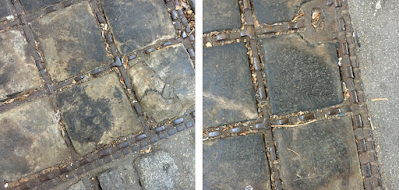I'm returning to wood block paving again, because I've found a few more patches that I'd like to share with you and add to the list.
This bygone type of street surface was used on some roads, mainly busy streets, but also in areas of high use as per in a courtyards or private access ways where the noise from horses' hooves could be kept to a minimum. But horses leave evidence wherever they go in the form of wet and gloopy stuff and these deposits made the streets of old rather stinky. The wood blocks were also often stolen for use as firewood ( though consider the aroma!).
Other forms of street surfaces superseded the wood blocks but it's still possible to find evidence here and there, mostly within man hole covers and just like finding an unusual shell on a beach, you then 'get your eye in' and start finding more – see my A-Z of London woodblocks here.
Here are two more new finds and an update...
This first one is a manhole cover I had spotted a few years ago and completely forgot about until recently. Having not made any note of it or taken any photos back then, I had to wander the streets to rediscover it. It sits in outside 111 Kentish Town Road. The wood within it is here clearly enhanced by the recent wet weather:
And, finally, a return to Leo Yard, Clerkenwell, that I mentioned in an earlier post – this side alley, just wide enough for a small horse and cart, is on the north side of Clerkenwell Road and leads to what would have been workshops and warehousing at the rear. The wood blocks here are set within a maintenance access plate which forms a pleasing grid pattern. The blocks are barely worn and most have have slightly domed tops. Also, the wood here appears to be a very dense type, more so than within the circular plates like the two shown above, perhaps offcuts from the furniture making industry here.
No doubt I'll find some more of these on my travels and I'll be writing 'Part 6' sometime soon... do let me know if you can add to the collection.






My family made their fortune, (or if not a fortune, a business) in tge 19th century importing the timber, jarrah, from West Australia. Super dense, hard and heavy, when freshly cut the sawdust is bright red.
ReplyDeleteHi Jane. I'd not seen the setts at 111 KT Road. If you'd have walked north a little you'd have found another wooden cover, just outside of B&S DIY (313). The only other one I've spotted in the area is in Camden, outside of the Havianas shop (217 place, Chalk Farm Rd). Best
ReplyDeleteThanks Jonno. I’ve already posted about the Chalk Farm Road ones. But I see Kentish Town Road needs further investigation. I’ll perhaps wander over that way later and check out Camden to TufPk.
ReplyDeleteI’ve also spotted some other ‘new’ ones in various locations…. I can see I am going to have to compile a directory!!
Thanks again, Jane
I'm assuming you've seen that I added lots more to the list since these comments: http://www.janeslondon.com/p/a-z-of-woodblocks.html
ReplyDelete